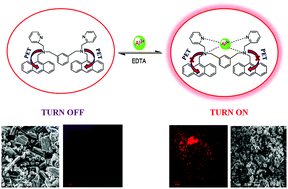Bis-anthracene derived bis-pyridine: selective fluorescence sensing of Al3+ ions†
Abstract
A novel bis-anthracene molecule linked to bis-pyridine by xylylene dibromide (APC) was synthesized as a potent sensor for the detection of Al3+ ions. Receptor APC exhibits high affinity towards Al3+ ions through fluorescence ‘off–on’ behaviour in HEPES-buffered THF–H2O (1 : 1, (v/v) HEPES = 50 mM, pH = 7.4) solution with a detection limit of 0.89 × 10−6 M. The affinity between receptor APC and Al3+ ions can be attributed to the photoinduced electron transfer (PET) mechanism. Furthermore, the receptor APC can be employed for the detection of Al3+ ions in various effluent water samples and in microbial bioimaging.



 Please wait while we load your content...
Please wait while we load your content...